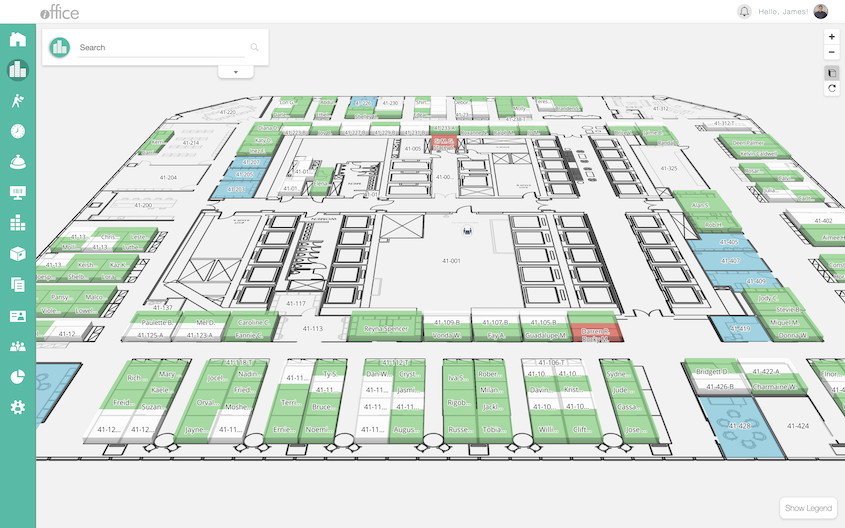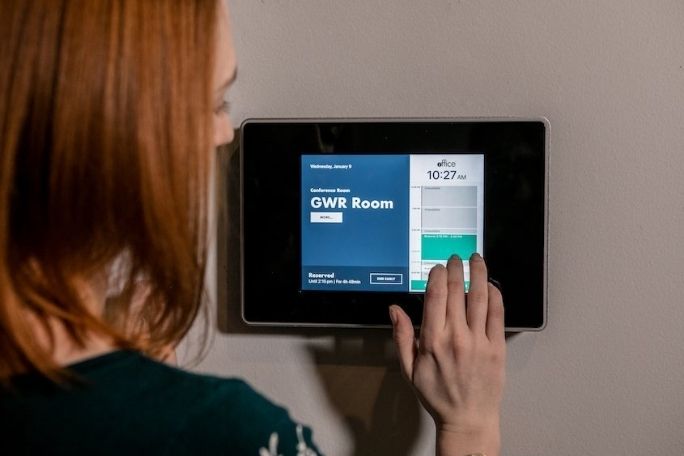What Is A Workplace Management System?


Considering real estate is your second-largest expense, optimizing your use of office space can save hundreds of thousands each year.
A workplace management system makes it easy to see how every square foot of space is being used and helps you maintain it efficiently.
It’s also an essential part of improving business processes and your employee experience. If you haven’t used workplace management software before, here’s what you need to know.
What is a workplace management system?
A workplace management system is a software platform that helps facilities managers optimize the use of spaces and resources, with the end goal of improving efficiency, productivity, and your return on investment in real estate.
Traditionally, different functions — such as real estate, space management, and energy management — have been handled by different software vendors.
Integrated workplace management system (IWMS) software, a term coined by Gartner, is a broader solution that centralizes all these functions under one platform. This gives you better visibility into all your buildings, assets, and services so you can plan accordingly.
Key functions of a workplace management system
A workplace management system can include many different functions but typically has a few key components.
The most common ones are:
Space planning and workplace facilities management

Imagine a digital twin of your office space that allows you to see every building, floor, department, and individual desk.
This allows you to experiment with different space scenarios and find the best one depending on your goals.
If you want to improve space utilization, you could combine desks from two barely occupied floors into one and see how that change would impact your workforce.
Or, if you need to reduce density to ensure a safe return to work, you can create new floor plans with more distance between workspaces.
You can coordinate office moves more efficiently by creating work orders for all related tasks and notifying the right people.
You can also see real-time data on how all your spaces are being used, including:
- Occupancy rates by building and floor
- Which workspaces are occupied on a daily basis
- Which days of the week are busiest
- Which conference rooms are used most often
This allows you to make better business decisions. For instance, you might decide to convert large, underutilized conference rooms to several smaller spaces employees can reserve when they need a quiet place to work.
Energy management
Energy savings is a huge opportunity for facility managers. Without a workplace management system, it’s difficult to know how much electricity and gas you’re using and identify the greatest sources of waste.
With a workplace management system that integrates with an energy management platform, you can see your total utility consumption and costs. You can find opportunities for improvement, such as:
- Lowering thermostats during off-peak hours
- Using occupancy sensors to control lighting
- Regularly checking HVAC systems to ensure they’re running efficiently
- Weatherproofing areas where energy usage is higher than normal due to drafts
You can also use your workplace management system to automate work orders related to those issues. If your HVAC systems need to be serviced in the spring and fall, you can set reminders for your facilities management team at the beginning of each year.
You can even include instructions on what components to check and who to call if your team needs more assistance.
Workplace asset management
In asset-heavy industries such as construction, manufacturing, and logistics, equipment downtime can cost hundreds of thousands of dollars per hour. Other companies have important workplace assets, including data centers, printers, fax machines, computers and furniture.
Regardless of the size and type of business, every enterprise should perform preventive maintenance to optimize asset performance.
A workplace asset management system maintains a digital record of all your assets and important details, including location, manufacturer, purchase date, cost, and warranty information.
It makes it easy to schedule preventive maintenance and alert your facilities team when it’s time to inspect or replace something.
You can also track unplanned maintenance, including which parts your team replaced, how much they cost, and how many labor hours it took. At the end of each year, you can see exactly how much time you spent on preventive maintenance tasks compared to unexpected maintenance. Ideally, you should aim for 80% of your maintenance activities to be scheduled with only about 20% unplanned.
This will help you avoid downtime and costly last-minute repairs.
A workplace management system also stores valuable information for accounting and compliance purposes. To comply with lease accounting standards, you need to have detailed records for all leases with terms greater than 12 months.
Unfortunately, PwC research found as many as two-thirds of organizations were still using spreadsheets to track this information just a few years ago.
Capital project management
When enterprises take on large capital projects, they need to break down long-term goals into daily tasks. This includes creating project plans, managing bids, tracking budgets, reporting financial data, and storing documents.
All too often, well-meaning managers keep all the details for these multi-million dollar projects in spreadsheets, on shared Google Drive folders, or on their own personal computers. This leads to many different versions of the same document circulating via email and a lack of visibility into important deadlines.
Keeping all this information in one place improves transparency and accountability for everyone involved, from corporate real estate leaders to construction managers.
Many workplace management systems have built-in project management capabilities, while others integrate with third-party software.
Real estate, leasing, and portfolio management

If you’re managing more than one facility or property, you need a platform that includes all your real estate data and costs while helping you plan for the future.
A workplace management system helps you report on capital and operating leases by extracting data from multiple sources.
You can track important corporate real estate metrics, such as:
- Capitalization rate
- Total occupancy costs
- Percentage of revenue (adjusted gross profit divided by total occupancy costs)
- Space utilization by building
The best software makes it easy for real estate leaders and other executives to see this information in user-friendly dashboards.
Workplace management services

Services that help employees better navigate the built environment haven’t historically been part of workplace management systems, but this is changing — especially in today’s distributed workforce.
In McKinsey’s Future of Work survey, 85% of executives said they planned to provide new technology to support employee interaction and collaboration.
That includes:
- Software that integrates with employee directories so employees can find colleagues in a large office
- Wayfinding solutions that help them find specific places
- Desk booking software and room reservation software
- Service request software that makes it easy for them to get tech support or request repairs
The best workplace software brings all this into one mobile app employees can access anywhere.
Who uses a workplace management system?
Because a workplace management system has so many functions, it has a diverse group of users representing different roles. They include:
- Owners and leaders of large enterprises and growing companies
- Facilities managers
- HR leaders
- Asset and maintenance managers
- Corporate real estate (CRE) executives
- Sustainability managers
- Workplace experience leaders
Each of these users relies on different functions of an integrated workplace management system. For example, while facilities leaders and maintenance professionals may be more interested in features related to building and asset management, CRE leaders will want to see detailed information on your real estate portfolio. Workplace experience leaders will be interested in services that make employees’ lives easier, such as wayfinding and room and desk reservations. HR professionals may use workplace management systems to assist with onboarding and employee communications. And sustainability managers will want to use the same system to help the company reduce its carbon footprint.
What are the benefits of a workplace management system?
The benefits of an integrated workplace management system are many. Each functional pillar of IWMS brings its own strengths and lends corresponding benefits such as:
- Better space utilization
- Better operational efficiency
- Cost savings
- Better project management
- Improved asset management and prolonged asset life
- Energy savings
- Deeper insights powered by IoT and artificial intelligence
Here are some data points from the Research and Markets report that further validate the benefits of integrated workplace management systems:
- Improved space utilization by over 40%
- Improved workspace management by up to 40%
- Reduced enterprise asset lifecycle costs down by up to 30%
- Reduced facility maintenance costs by 14% on average
- Reduced energy consumption by 10% on average
Additionally, there are intangible benefits, such as the ability to attract and retain highly talented people. Employees want to work in a flexible environment with technology that helps them collaborate with their colleagues and empowers them to be productive. An integrated workplace management system makes this possible by connecting people, places, and data.
How do you compare workplace management systems?
With many workplace management systems in the market, how do you decide which one is right for you? These questions can help you evaluate your options:
Is the solution on-premise or in the cloud?
On-premise solutions can be expensive to build and maintain. Software-as-a-service (SaaS) solutions typically include hosting, infrastructure, and upgrades in the monthly or annual subscription price.
How configurable is the software?
Because workplace management solutions are used across industries, many of them include standard capabilities. While this is a good starting point, look for one that allows you to create custom workflows, reporting, and integrations with other technology.
Does it integrate with IoT sensors?
Sensors make it possible to gather real-time data on space utilization, asset performance, and more. Look for a system that integrates easily with different types of sensors.
Does it improve business intelligence?
Look for software with robust reporting and user-friendly dashboards that make it easy for you to see how you’re doing when it comes to the facility management KPIs that matter most.
Does it improve your employee experience?
The best workplace management technology includes intuitive apps for employees in addition to all the functionality your management teams expect. It should connect employees to the resources they need to be productive from anywhere.
Why iOFFICE is the right choice
iOFFICE’s integrated workplace management system goes far beyond the standard functionality of traditional workplace management software. In addition to supporting the needs of your corporate real estate, facilities, and HR leaders as you return to the office, it’s designed to optimize the employee experience.
It’s built to integrate easily with the applications you already use, as well as emerging technology like sensors and artificial intelligence. And its Hummingbird workplace app makes it easy for your workforce to find and reserve safe places to work, request service, and more.
iOFFICE makes it easy to implement a flexible workplace strategy and manage everything that goes along with it, from reservations to the data you need to plan ahead.
In recent customer surveys:
- 95% said our workplace management system was easy to use
- 53% said it increased employee productivity
- 52% said they saw a return on investment within three months
- 44% said it allowed them to reduce their workplace technology stack
You can estimate your savings using a few simple calculations, but the best way to see how iOFFICE will benefit your workforce and your bottom line is to see it for yourself.
